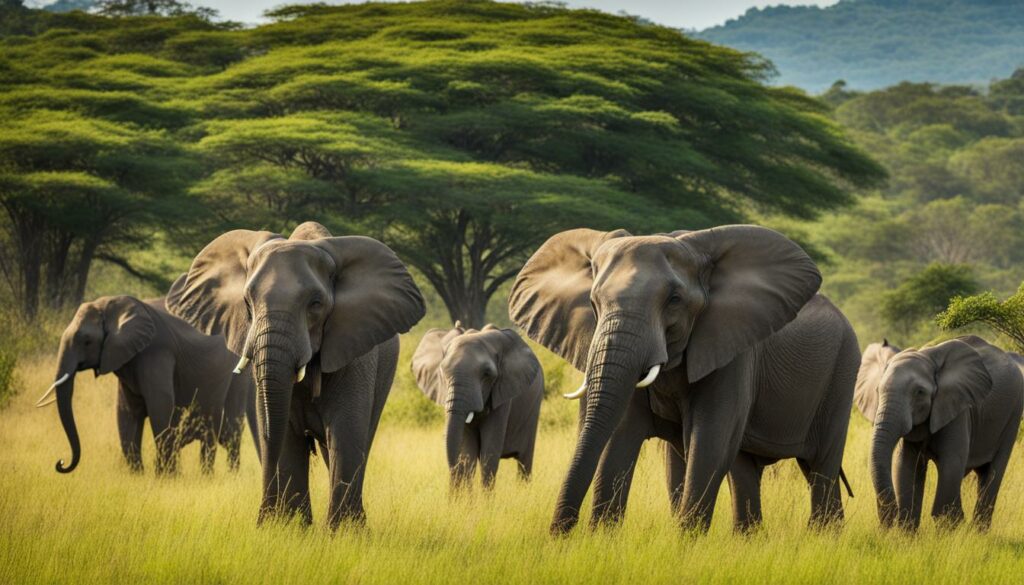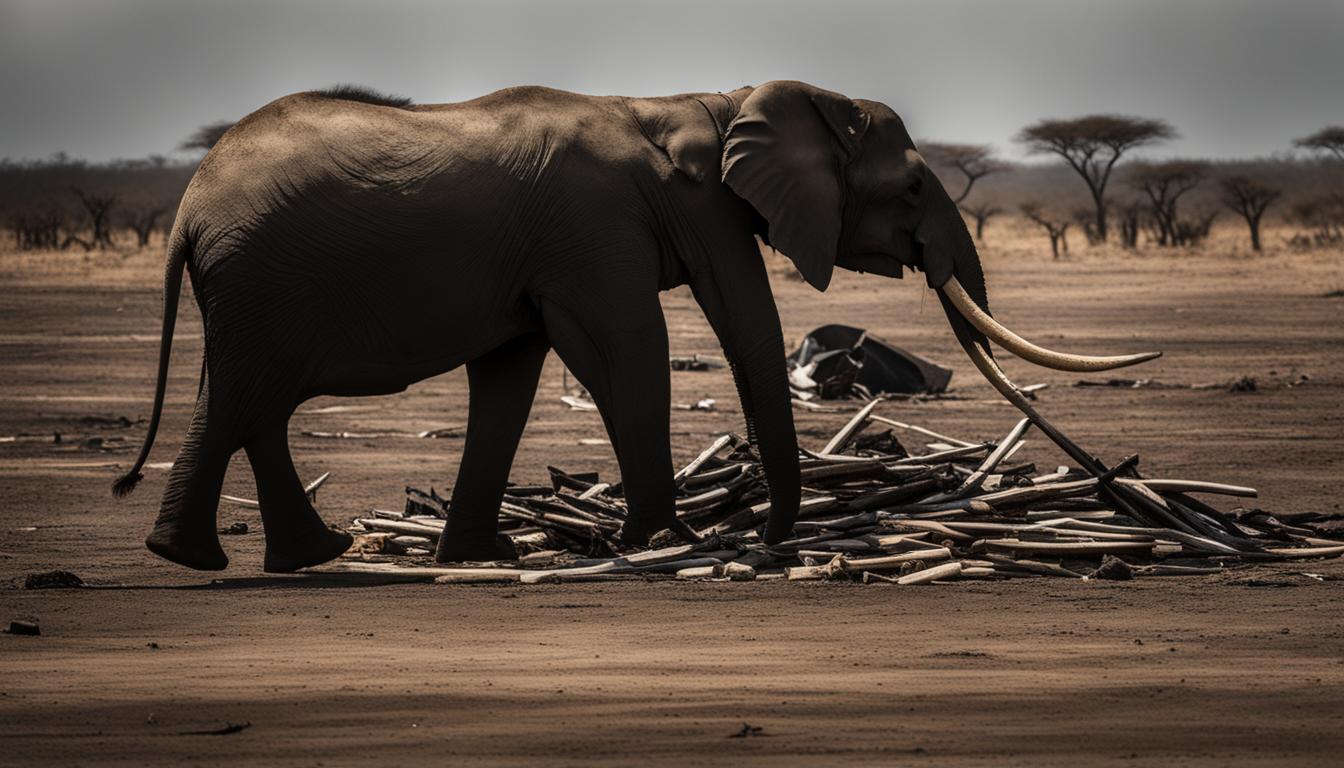Welcome to our article on the devastating consequences of elephant poaching and the efforts being made to conserve these majestic creatures. Elephant poaching, also known as the illegal hunting of elephants, has a significant impact on elephant populations worldwide.
Studies from Colorado State University and Save the Elephants have shed light on the consequences of poaching, revealing the key role that juvenile elephants play in population dynamics. Previous conservation efforts focused primarily on older elephants, but research now shows that the survival of juvenile elephants is crucial for population growth or decline.
Human activity, such as the wounding or killing of elephants, has a detrimental effect on their survival rates across all ages. In this article, we will explore the importance of juvenile elephants in population dynamics, the impact of poaching on elephant behavior, and the role of human activity in elephant survival. We will also discuss declining poaching rates and potential solutions, as well as the importance of targeted conservation actions.
The Importance of Juvenile Elephants in Population Dynamics
Recent research has shed light on the crucial role that juvenile elephants play in the overall health and growth of elephant populations. Contrary to previous assumptions, it is now understood that the survival of juvenile elephants is a key factor in determining population trends. When the survival of juvenile elephants is high, it provides a protective buffer against population decline. On the other hand, a decline in the survival of juveniles indicates trouble for the population as a whole.
This newfound understanding challenges the notion that older elephants are the primary drivers of population dynamics. By recognizing the importance of juvenile elephants, conservationists and governments can implement more targeted actions to ensure the long-term survival of elephant populations. This includes focusing on factors that directly impact the survival rates of juveniles, such as poaching, habitat loss, and human-wildlife conflict.
To illustrate the significance of juvenile elephants in population dynamics, consider the following table:
| Age Group | Survival Rate | Population Growth/Decline |
|---|---|---|
| Adults (25+ years) | 90% | Stable |
| Sub-Adults (10-25 years) | 80% | Stable |
| Juveniles (2-10 years) | 70% | Increase |
| Calves (0-2 years) | 50% | Decrease |
This table demonstrates how a decline in the survival rates of juvenile elephants can lead to a decrease in population growth. Conversely, a high survival rate among juvenile elephants contributes to population growth. Therefore, protecting and conserving juvenile elephants is crucial for the long-term stability and growth of elephant populations.
The Impact of Poaching on Elephant Behavior
As we delve deeper into understanding the impact of poaching on elephant populations, it becomes evident that this illegal hunting not only directly affects individual elephants but also has profound consequences for their behavior and demographics. One significant result is the negative effect on orphaned offspring, who struggle to survive without the support of their mothers. Even orphans that have been weaned show a lower chance of survival without maternal guidance. This highlights the broader consequences of poaching, extending beyond the loss of individual elephants to the survival of their dependent offspring.
The death of adult elephants due to poaching not only reduces population growth but also disrupts the social dynamics of elephant herds. Elephants are highly social animals, and the loss of key individuals, especially mature females who play crucial roles in herd cohesion and knowledge transfer, can have cascading effects on the behavior and dynamics of the remaining members. Poaching, therefore, has a larger impact on social populations than initially thought.
The Impact on Elephant Behavior
Poaching-induced disruptions to elephant populations result in changes to their behavior. Orphaned elephants experience a significant shift in their social structure, as they lose the guidance and support of their mothers. This loss can lead to increased stress, decreased survival rates, and altered behavior patterns among the orphaned individuals. The social dynamics within herds may also be affected, as the loss of mature females disrupts the hierarchy and knowledge transfer within the group. These behavioral changes can further amplify the consequences of poaching, exacerbating the decline in elephant populations.
| Effects of Poaching on Elephant Behavior | Consequences |
|---|---|
| Increase in orphaned elephants | Higher stress levels and decreased survival rates among orphaned individuals. |
| Loss of mature females | Disruption of social hierarchy and knowledge transfer within herds. |
| Altered behavior patterns | Changes in communication, foraging, and movement patterns due to social disruptions. |
Understanding the impact of poaching on elephant behavior is crucial for developing effective conservation strategies. By considering the broader consequences, including the survival and behavioral changes of orphaned offspring, conservationists can implement targeted efforts to mitigate the adverse effects of poaching on elephant populations. These efforts may involve interventions focused on providing support and care for orphaned elephants, as well as initiatives aimed at protecting and preserving the social structures within elephant herds.
The Role of Human Activity in Elephant Survival
Human activity, particularly related to the ivory trade, has a significant impact on the survival of elephants. The research shows that even for calves, which are not typically targeted for their ivory, their survival is strongly influenced by human impact on the population. The study emphasizes that killing one elephant has downstream effects on other elephants that are bonded to it. This understanding highlights the need for increased conservation efforts and governmental actions to address illegal hunting, wildlife trafficking, and the ivory trade.
By comprehending the dominant role of human impact, conservationists can develop more effective strategies to protect elephant populations. The alarming statistics demand urgent action to curb the detrimental effects of human activity on elephant survival. Increased law enforcement efforts and international cooperation are essential to combat the ivory trade and wildlife trafficking. Moreover, addressing the root causes of ivory demand, such as raising awareness about the ethical implications and promoting sustainable alternatives, can play a crucial role in reducing the incentives for poaching and illegal trade.
The involvement of local communities in conservation efforts is also vital. By providing alternative livelihood options and education, it is possible to alleviate poverty and reduce the reliance on illegal activities such as poaching. Empowering communities to become stewards of the environment can create a sustainable future for both elephants and humans. Collaboration between governments, NGOs, and local communities is crucial to implement comprehensive measures that tackle the complex issues contributing to elephant population decline.
“The survival of elephants is in our hands. It is up to us to protect these magnificent creatures and preserve their habitats for future generations.” – Jane Goodall
The Human Impact on Elephant Survival: A Call to Action
The fate of elephant populations rests on our shoulders. We have the power to make a difference through our actions and choices. By actively supporting conservation efforts, advocating for stronger wildlife protection laws, and making responsible consumer choices, we can help ensure the survival of elephants in the face of human-driven threats.
| Conservation Actions | Impact |
|---|---|
| Strengthening law enforcement | Reduces illegal poaching and wildlife trafficking |
| Raising awareness about the ivory trade | Reduces demand for ivory products |
| Supporting sustainable community development | Reduces reliance on poaching as a livelihood option |
| Investing in conservation research and monitoring | Provides valuable insights for targeted interventions |
Together, we can halt the decline of elephant populations and secure a future where these majestic creatures roam free. It is time to take a stand and protect the elephants that have been a part of our world for millions of years. Let us be the generation that ensures their survival.
Declining Poaching Rates and Potential Solutions
Recent data suggests a promising decline in poaching mortality rates, providing hope for the conservation of elephant populations. This positive trend is attributed to the implementation of various conservation interventions, particularly stronger law enforcement efforts. However, to further reduce poaching and protect these magnificent creatures, it is vital to address the root causes driving poaching rates.
The main driver of poaching is the demand for ivory, which fuels illegal hunting and wildlife trafficking. By reducing the demand for ivory in major markets, we can significantly impact poaching rates and protect elephant populations. Additionally, tackling corruption within law enforcement and addressing poverty in poaching-prone regions are crucial steps in curbing the illegal trade.
“The decline in poaching rates provides an opportunity for conservationists to intensify their efforts in protecting elephants and their habitats. By collaborating with governments, communities, and other organizations, we can develop comprehensive strategies that address both the supply and demand sides of poaching,”
says Dr. Samantha Wilson, a leading expert in wildlife conservation.
| Poaching Factors | Solutions |
|---|---|
| Ivory demand | Reduce demand through public awareness campaigns and stricter regulations. |
| Corruption | Implement anti-corruption measures within law enforcement agencies. |
| Poverty | Alleviate poverty in poaching-prone regions through sustainable development initiatives. |
While the decline in poaching rates is promising, continued investment in law enforcement efforts is crucial. Strengthening patrols, improving surveillance technologies, and enhancing interagency cooperation can further deter poachers and protect elephant populations.
By addressing the underlying factors driving poaching – ivory demand, corruption, and poverty – we can ensure the long-term survival of elephants. It is through collaborative conservation efforts, effective law enforcement, and sustainable development that we can safeguard these magnificent creatures for future generations.

Importance of Targeted Conservation Actions
In order to protect elephant populations and ensure their long-term survival, it is crucial to implement targeted conservation actions that address the specific needs and challenges faced by these magnificent creatures. To effectively combat the impact of poaching, it is essential to focus on preserving the survival of orphaned elephants, as their struggle without maternal support has a significant impact on population growth or decline. By understanding the unique demographic dynamics of elephant populations, conservation efforts can be tailored to different age groups and social structures, maximizing their impact.
Focusing on Orphan Survival
One key aspect of targeted conservation actions is prioritizing the survival of orphaned elephants. These vulnerable individuals face numerous challenges and have a lower chance of survival without the support of their mothers. By implementing measures that provide aid, protection, and rehabilitation for orphaned elephants, conservationists can help ensure their well-being and contribute to the overall growth and stability of elephant populations. This targeted approach recognizes the vital role that orphaned elephants play in the dynamics of their respective herds.
Addressing the Impact of Poaching
Another crucial aspect of targeted conservation actions is addressing the impact of poaching on elephant populations. Poaching not only directly affects individual elephants but also has far-reaching consequences on population dynamics and survival. By focusing on specific populations that are most affected by poaching, conservation efforts can be concentrated in areas where urgent intervention is needed. This targeted approach allows for more efficient use of resources and increases the chances of success in combating poaching.
Collaborative Efforts and Partnerships
Targeted conservation actions require collaborative efforts and partnerships between governments, local communities, non-governmental organizations, and other stakeholders. By working together, sharing knowledge and resources, and combining expertise, we can develop comprehensive strategies that address the complex challenges faced by elephant populations. These collaborative efforts can also help raise awareness, mobilize support, and promote sustainable practices in the regions where elephants reside.
Conclusion
The research clearly shows the devastating impact of elephant poaching on populations. Not only does poaching directly harm individual elephants, but it also leads to a decline in population numbers. This decline is particularly significant for juvenile and orphaned elephants, who struggle to survive without the support of their herd.
To combat elephant poaching effectively, focused conservation efforts are vital. It is crucial to address the specific needs of different age groups and social structures within elephant populations. This can be achieved through a combination of rigorous anti-poaching measures, efforts to reduce the demand for ivory, and initiatives to tackle corruption and poverty. By implementing these comprehensive strategies, we can contribute to the conservation of these majestic creatures and work towards preventing their decline.
Protecting elephant populations requires a collaborative approach involving governments, conservation organizations, and individuals like you. Together, we can support anti-poaching initiatives, raise awareness about the devastating impact of poaching, and promote responsible tourism practices. By joining hands, we can ensure a brighter future for elephants and preserve their place in our natural world for generations to come.
How Does Poaching Contribute to Human-Elephant Conflicts?
Poaching exacerbates human-elephant conflicts by intensifying the human-elephant conflict’s impact on populations. The illegal trade of ivory and other elephant parts fuels the demand, leading to the killing of elephants. As their numbers dwindle, elephants encroach on human settlements, resulting in property damage, crop destruction, and sometimes even loss of human lives. This vicious cycle further intensifies the human-elephant conflict’s impact on populations, posing a grave threat to both humans and elephants.
FAQ
What is the impact of poaching on elephant populations?
Poaching has a significant impact on elephant populations, leading to population decline and disruption of population dynamics.
Why are juvenile elephants important in population dynamics?
Recent studies have shown that juvenile elephants play a critical role in population growth and decline, and their survival is crucial for the overall health of elephant populations.
How does poaching affect elephant behavior?
Poaching not only directly affects individual elephants but also has broader consequences on elephant behavior, including the survival of orphaned offspring and social dynamics within elephant populations.
What is the role of human activity in elephant survival?
Human activity, particularly related to the ivory trade, is the primary factor affecting elephant survival. Killing one elephant has cascading effects on other elephants bonded to it, leading to decreased survival rates and population decline.
Are poaching rates declining, and what solutions are being considered?
Poaching rates have been on a decline, thanks to increased conservation interventions and stronger law enforcement efforts. However, addressing underlying factors such as ivory demand, corruption, and poverty is crucial in further reducing poaching.
Why are targeted conservation actions important?
Targeted conservation actions are essential to address the specific needs of different age groups and social structures within elephant populations. By focusing on orphan survival and population dynamics, conservation efforts can have a more significant and lasting impact.
What is the conclusion regarding elephant poaching and conservation?
Elephant poaching has a devastating impact on populations, but with comprehensive strategies that include law enforcement, reducing ivory demand, and addressing social and economic factors, we can work towards preventing their decline and ensure their long-term survival.










